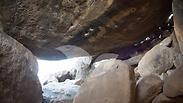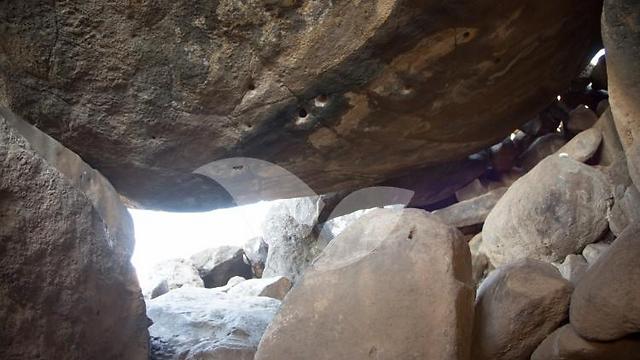
Ancient stone engraving unearthed in Upper Galilee
Archeologists unearth a 4,000-year-old stone engraving during excavations in the Upper Galilee; 'This is the first art ever documented in a dolmen in the Middle East.'
According to the Israel Antiquities Authority, the dolmen was discovered inside a large chamber measuring 2 by 3 meters, and was covered by an enormous stone estimated to weigh at least 50 tons, one of the largest stones ever used in the construction of dolmens in the Middle East.
The dolmen itself was enclosed in an enormous stone heap (tumulus) approximately 20 meters in diameter, and its stones are estimated to weigh a minimum of 400 tons. At least four smaller dolmens that were positioned at the foot of the decorated dolmen were identified inside the stone heap.
“In other words, what we have here is a huge monumental structure built hierarchically (with a main cell and secondary cells). This is the first time such a hierarchical dolmen has been identified in the Middle East,” said the IAA in a release.
The dolmen was discovered by Professor Gonen Sharon of the Galilee Studies Program at the Tel Hai College and is just one of some 400 stone structures dating to the Intermediate Bronze Age that are located in a field first unearthed by the late Moshe Kagan in the 1950’s.
Experts said the latest find sheds new light on the nature of dolmens in ancient Israel. “This is the first art ever documented in a dolmen in the Middle East”, said Uri Berger, an archaeologist with the Israel Antiquities Authority and partner in the study.
“The engraved shapes depict a straight line going to the center of an arc. About fifteen such engravings were documented on the ceiling of the dolmen, spread out in a kind of arc along the ceiling. There are no other similar engraved rock drawings known to exist in these shapes in the Middle East, and their significance remains a mystery.”
The panel depicting the art was scanned in the field by the Computerized Archaeology Laboratory of the Hebrew University. The resulting three-dimensional model of the engraving allowed researchers to study the dolmen with precision not previously available.
“The three-dimensional scan enabled us to identify engravings that otherwise could not be seen with the naked eye,” explained Professor Lior Grossman, the laboratory director.
Experts also said the dolmen provides evidence of “a significant and established governmental system in the region during the Bronze Age."
“Archaeologists tend to interpret the past based on material finds,” said the IAA. “The absence of cities, large settlements and monumental buildings attests to the collapse of the governmental and economic systems during a ‘dark period’ in history. The dolmens tell a different story about the period—a story about a society that had a complex governmental and economic system that executed monumental engineering projects but did not leave behind any other archaeological evidence.”
“The gigantic dolmen at Kibbutz Shamir is without doubt an indication of public construction,” added Professor Sharon, “that required a significant amount of manpower over a considerable period of time. During that time all of those people had to be housed and fed.
"The building of such a huge construction necessitated knowledge of engineering and architecture that small nomadic groups did not usually possess. And even more importantly, a strong system of government was required here that could assemble a large amount of manpower, provide for the personnel and above all, direct the implementation and control of a large and lengthy project.”
Republished with permission from the Tazpit News Agency.











